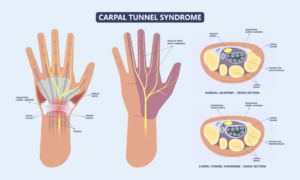Carpal tunnel syndrome (CTS) is incredibly common. In fact, it impacts more than 3 million Americans each year. CTS can cause pain, tingling, and/or numbness in the hand and arm. To help better understand carpal tunnel syndrome, we’ll answer the following questions in this blog post: Who? What? When? Where? Why? and How? First, let’s start with the, ‘what?’.
WHAT is carpal tunnel syndrome?
Numbness, tingling, and weakness in the hand, wrist, and arm are all key indicators of CTS. Symptoms are most likely to affect the thumb, index, middle, and ring fingers. These symptoms are caused by pressure on the median nerve, which runs down the arm from your elbow. It passes through the “carpal tunnel” in the wrist and ends in the hand.

WHERE is the carpal tunnel located?
If you flip your hand palm side up and find where your hand meets your wrist, you will see the location of the carpal tunnel. It is a literal tunnel formed by the bones and muscles of the wrist. As we mentioned above, it holds ligaments and nerves, including the median nerve, that flow from the arm down to the wrist and fingers.
WHY does carpal tunnel syndrome occur?
Often, CTS is the result of a number of things that increase pressure on the median nerve and tendons within the carpal tunnel. Some of these may include a wrist sprain or fracture that caused the carpal tunnel to shrink; rheumatoid arthritis; an overactive pituitary gland; or an underactive thyroid gland. Additional factors could include repeated use of vibrating machinery or any repetitive motion with your hands, the development of a cyst or tumour within the carpal tunnel, or even fluid retention during pregnancy or menopause.
 WHO is at risk for carpal tunnel syndrome?
WHO is at risk for carpal tunnel syndrome?
Interestingly, women are three times more likely than men to develop carpal tunnel syndrome. Also, people with diabetes or other metabolic disorders are also at higher risk. Typically, CTS only occurs in adults.
Often, workplace factors also play a role in the development of CTS. Though the condition is often associated with computer-related jobs, it is reported more in those who perform assembly line work such as manufacturing, sewing, cleaning, and meatpacking. However, the risk of developing CTS is not confined to people in a single industry or job.
HOW is carpal tunnel syndrome diagnosed and treated?
How is CTS diagnosed?
Initially, your physician may do a physical exam to test wrist function and order an x-ray at your first office visit. Next, he or she may order an MRI or an EMG.
- MRI (Magnetic Resonance Imaging): An MRI is a common diagnostic imaging study that shows images of the joints, ligaments, and muscles.
- EMG (Electromyography): An EMG is a nerve conduction study performed by placing needles into the muscles and sending a low pulse of electrical currents to “shock” the nerve and produce a muscle contraction. Then, that contraction is measured. At first, the test may cause slight discomfort, but the feeling should not last. As a result of this test, patients with carpal tunnel syndrome will show slower reaction times to the electric current because their carpal tunnel is smaller or closing around the median nerve.
If the results of these tests show signs of carpal tunnel syndrome, your doctor will likely recommend a conservative approach before jumping right into surgery.
 How is CTS treated?
How is CTS treated?
- Conservative Treatment: Often, this condition can be treated with rest, anti-inflammatory medication, and physical therapy. Additionally, a carpal tunnel brace may be ordered by your doctor that will hold the wrist in place while sleeping or working to reduce pinching the median nerve. Furthermore, your doctor may recommend reducing working hours or a lifting limit to give your wrists a break. Anti-inflammatories will bring swelling down and allow the nerve to get its required space back. If none of these options work, your doctor may suggest going to occupational therapy. There, a therapist can create a custom splint rather than a generic brace and teach you exercises to strengthen the wrist muscles. Your doctor may also recommend cortisone injections.
- Surgical Treatment: Finally, if conservative treatments do not work, your doctor may recommend carpal tunnel release surgery. During this procedure, the surgeon makes an incision on the wrist and cuts the ligament above the carpal tunnel. In essence, this ‘release’ gives the median nerve and other ligaments the room they need to function and should stop the tingling and pain through the hand. After surgery, patients should attend occupational therapy to ensure the range of motion and strength of the hand and wrist are as they should be. Sticking to the occupational therapy plan the doctor orders is incredibly important to the healing of the hand and wrist. In fact, not doing so may result in a loss of full range of motion. The recovery process may take a few days or a few months, depending on the patient and how damaged their ligaments or bones are.
WHEN should I talk to a doctor?
While not fatal, prolonged carpal tunnel syndrome without treatment can lead to loss of function of the hand and permanent damage to the nerves. So, if symptoms from carpal tunnel syndrome impact your everyday life, we recommend consulting a physician immediately. As always, if you have any form of undiagnosed chronic and/or severe pain it is important to see an expert ASAP to determine the root cause of the pain. So, consult with a physician as soon as possible to ensure you receive a proper diagnosis and treatment plan.
Advanced Ortho and Spine Can Help.
At Advanced Ortho and Spine (AOS), we’ve cared for numerous patients with CTS. Most are able to get back to living their best lives with only conservative treatment. Dr. Erik Maryniw at AOS specializes in treating a variety of orthopaedic conditions, including carpal tunnel syndrome. Request an appointment online or call us at 615.885.0200 to schedule yours today.
What’s the difference between carpal tunnel syndrome and cubital tunnel syndrome?
If you want to learn how carpal tunnel syndrome differs from cubital tunnel syndrome, check out our blog post entitled, Carpal Tunnel Syndrome vs. Cubital Tunnel Syndrome: What’s the difference?
 Dr. Erik Maryniw is a Board-Certified Hand and Upper Extremity Orthopaedic Surgeon at Advanced Ortho and Spine. He provides a full spectrum of orthopaedic care and microvascular surgery from the hand to the shoulder. Contact us today for more information or to request an appointment.
Dr. Erik Maryniw is a Board-Certified Hand and Upper Extremity Orthopaedic Surgeon at Advanced Ortho and Spine. He provides a full spectrum of orthopaedic care and microvascular surgery from the hand to the shoulder. Contact us today for more information or to request an appointment.

With two locations near Nashville in Mt. Juliet and Hermitage, Advanced Ortho and Spine provides patients with high-quality, personalized care while advancing orthopaedic excellence. Contact us today to learn more or to schedule your appointment.
Disclaimer: This blog provides general information and discussions about health and related subjects. The information and other content provided in this blog, or in any linked materials, are not intended and should not be construed as medical advice, nor is the information a substitute for professional medical expertise or treatment.If you or any other person has a medical concern, you should consult with your healthcare provider or seek other professional medical treatment. Never disregard professional medical advice or delay in seeking it because of something read on this blog or in any linked materials. If you think you may have a medical emergency, call your doctor or emergency services immediately.
The opinions and views expressed on this blog and website have no relation to those of any academic, hospital, health practice, or other institution.
